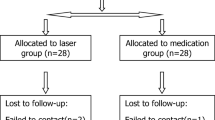Abstract
This study was aimed to evaluate the frequency of recurrent aphthous stomatitis (RAS) within the 6-week period after quitting smoking. The study group consisted of 90 subjects. Oral, medical findings and tobacco habits were recorded for all subjects. Nicotine replacement therapy (NRT) and behavioral treatment were applied to some of the subjects by a family physician. All subjects were evaluated for their RAS and periodontal measurements on baseline, 1, 3, 6 weeks by a periodontist. While the subjects were in this smoking cessation programme, 64 of the 90 smokers successfully quit smoking within the 6 weeks and 26 smokers dropped out during the third week of the study. Point prevalence of RAS among the subjects on the first day of the quitting period and at the end of the first, third and sixth week after smoking cessation was 3.3% (3/90), 18.9% (17/90), 21.1% (19/90) and 17.1 (11/64), respectively. In the following weeks, aphthous ulcer point prevalence was significantly higher than the quitting level (p < 0.05). As the time after quitting increased, the incidence of aphthous ulcer decreased. Of 64 patients, 35 (54.6%) completed the 6 weeks using NRT and 29 (45.4%) of them did not use any medication. The aphthous ulcer frequency observed in the patients taking NRT [11.4% (4/35)] was lower when compared with the subjects taking no NRT [24.1% (7/29)] (p > 0.05). The results of this study confirm that RAS is a complication of quitting smoking. Further studies are needed to identify the effects of NRT on RAS.

Similar content being viewed by others
References
Araki S, Murata K, Ushio K, Sakai R (1983) Dose–response relationship between tobacco consumption and melanin pigmentation in the attached gingiva. Arch Environ Health 38:375–378
Axell T, Henricsson V (1985) Association between recurrent aphthous ulcers and tobacco habits. Scand J Dent Res 93:239–242
Bittoun R (1991) Recurrent aphthous ulcers and nicotine. Med J Aust 154:471–472
Cicek Y, Canakci V, Ozgoz M, Ertas U, Canakci E (2004) Prevalence and handedness correlates of recurrent aphthous stomatitis in the Turkish population. J Public Health Dent 64:151–156
Embil JA, Stephens RG, Manuel FR (1975) Prevalence of recurrent herpes labialis and aphthous ulcers among young adults on six continents. Can Med Assoc J 113:627–630
Fagerstrom KO, Heatherton TE, Kozlowski LT (1992) Nicotine addiction and its assessment. Ear Nose Throat J 69:763–768
Fahmy MS (1976) Recurrent aphthous ulcerations in a mixed Arab community. Community Dent Oral Epidemiol 4:160–164
Garcia-Pola Vallejo MJ, Martinez Diaz-Canel AI, Garcia Martin JM, Gonzalez Garcia M (2002) Risk factors for oral soft tissue lesions in an adult Spanish population. Community Dent Oral Epidemiol 30:277–285
Griesel AG, Germishuys PJ (1999) Salivary immunoglobulin A levels of persons who have stopped smoking. Oral Surg Oral Med Oral Pathol Oral Radiol Endod 87:170–173
Hedin CA (1977) Smokers’ melanosis. Occurrence and localization in the attached gingiva. Arch Dermatol 113:1533–1538
Hedin CA, Axell T (1991) Oral melanin pigmentation in 467 Thai and Malaysian people with special emphasis on smoker’s melanosis. J Oral Pathol Med 20:8–12
Kovac-Kovacic M, Skaleric U (2000) The prevalence of oral mucosal lesions in a population in Ljubljana, Slovenia. J Oral Pathol Med 29:331–335
Mallın R (2002) Smoking cessation: integration of behavioral and drug therapies. Am Fam Physician 65:1107–1114
McRobbie H, Hajek P, Gilison F (2004) The relationship between smoking cessation and mouth ulcers. Nicotine Tob Res 6:655–659
Messadi DV, Waibel JS, Mirowski GW (2003) White lesions of the oral cavity. Dermatol Clin 21:63–78
Mirbod SM, Ahing SI (2000) Tobacco-associated lesions of the oral cavity: part I. Nonmalignant lesions. J Can Dent Assoc 66:252–256
Morozumi T, Kubota T, Sato T, Okuda K, Yoshie H (2004) Smoking cessation increases gingival blood flow and gingival crevicular fluid. J Clin Periodontol 31:267–272
Muller HP, Stadermann S (2006) Multivariate multilevel models for repeated measures in the study of smoking effects on the association between plaque and gingival bleeding. Clin Oral Investig 10:311–316
Özbayrak S (1983) Zur Fage der Rauchermelanose der Mundschleimhaut. Thesis, Berlin Freinen Universität, Berlin
Scheid P, Bohadana A, Martinet Y (2000) Nicotine patches for aphthous ulcers due to Behçet’s syndrome. New Engl J Med 343:1816–1817
Scully C, Gorsky M, Lozada-Nur F (2003) The diagnosis and management of recurrent aphthous stomatitis: a consensus approach. J Am Dent Assoc 134:200–207
Scully C, Shotts R (2000) ABC of oral health. Mouth ulcers and other causes of orofacial soreness and pain. BMJ 321:162–165
Shiffman S, Rolf CN, Hellebusch SJ, Gorsline J, Gorodetzky CW, Chiang YK et al (2002) Real-world efficacy of prescription and over-the-counter nicotine replacement therapy. Addiction 97:505–516
Sklavunou-Andrikopoulou A, Maragou P (2000) Recurrent aphthous ulcers. Current status on the etiology and management. Balk J Stomatol 4:129–134
Ünsal E, Paksoy C, Soykan E, Elhan AH, Şahin M (2001) Oral melanin pigmentation related to smoking in a Turkish population. Community Dent Oral Epidemiol 29:272–277
US Department of Health and Human Services (1990) The health benefits of smoking cessation. A report of the Surgeon General. Public Health Service, Centers for Disease Control, Office on Smoking and Health, Rockville, Maryland
Ussher M, West R, Steptoe A, McEwen A (2003) Increase in common cold symptoms and mouth ulcers following smoking cessation. Tob Control 12:86–88
Wallström M, Nilsson F, Hırsch JM (2000) A randomized, double-blind placebo-controlled clinical evaluation of a nicotine sublingual tablet in smoking cessation. Addiction 95:1161–1171
Zain RB (2000) Oral recurrent aphthous ulcers/stomatitis: prevalence in Malaysia and an epidemiological update. J Oral Sci 42:15–19
Author information
Authors and Affiliations
Corresponding author
Rights and permissions
About this article
Cite this article
Marakoğlu, K., Sezer, R.E., Toker, H.Ç. et al. The recurrent aphthous stomatitis frequency in the smoking cessation people. Clin Oral Invest 11, 149–153 (2007). https://doi.org/10.1007/s00784-007-0102-7
Received:
Accepted:
Published:
Issue Date:
DOI: https://doi.org/10.1007/s00784-007-0102-7




